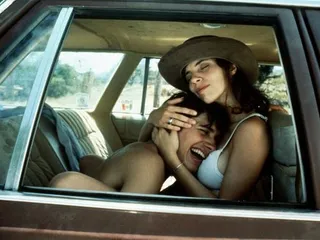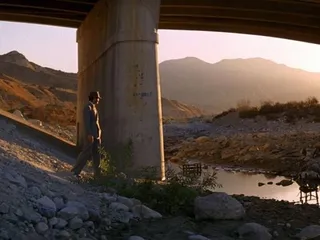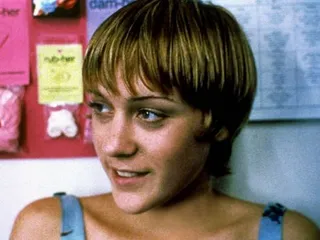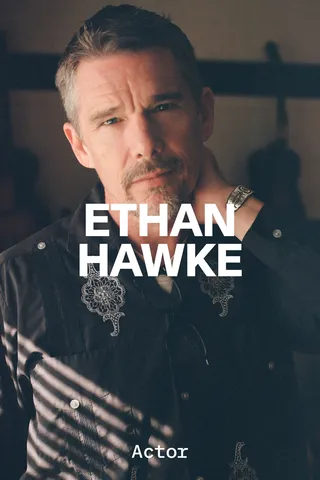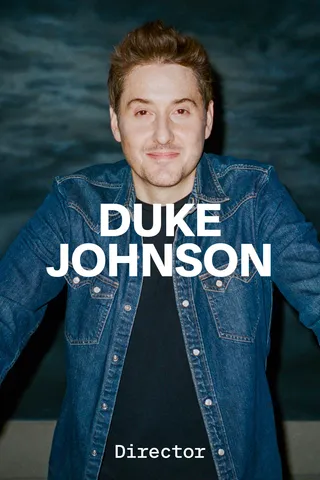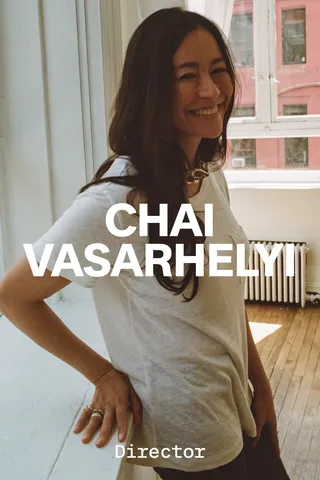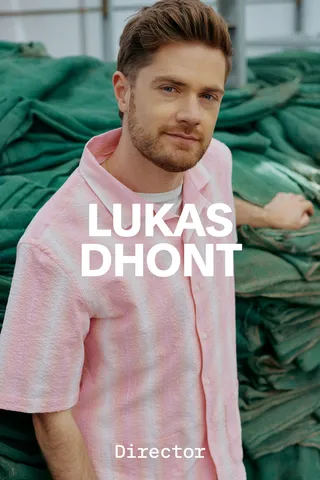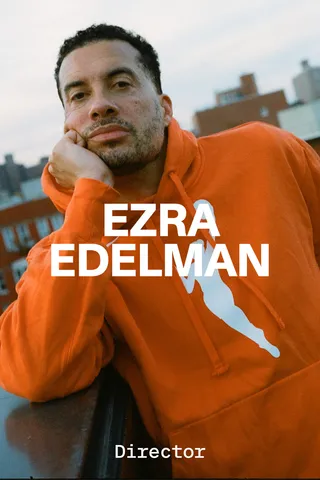Kimberly Peirce
When Kimberly Peirce was growing up, movies were her escape hatch, a place of coherent structure during an itinerant childhood in a splintered, larger-than-life family. After studying at the University of Chicago and working as a photographer in Japan, she moved to New York City to pursue an MFA in film at Columbia. Speaking to Galerie, the director of award-winning true-crime thriller Boys Don’t Cry (1999), Iraq War drama Stop-Loss (2008) and deluxe horror remake Carrie (2013) extolls the power of films about idiosyncratic, transcendent human connection: the exhilarating queerness of Billy Wilder’s Some Like It Hot (1959), the genius editing choices that transformed Woody Allen’s Annie Hall (1977) into a rom-com classic, the lingering sensuality of cinematographer Emmanuel Lubezki’s long takes in Alfonso Cuarón’s Y tu mamá también (2001). “What I really yearn for is a story where I fall in love with the characters,” Peirce explains. “I love when they bring something out in one another that deepens their soul.”
A PERSONAL MESSAGE
my FILM LIST
Click each title to discover our curator’s notes and where to watch
A perfect movie. Maybe I should call out a spoiler alert here because I don’t know the exact shot, but I do know the gist of the ending: You have the most handsome guy you can imagine, Montgomery Clift. Now, he’s a lower class guy, but he’s connected to some money because his family is like the Kodak family. But he’s started at the bottom and he’s working his way up. He’s doing great, he’s working hard and he’s with a girl. He’s not going marry her, but he wants to fuck her, and he does and she gets pregnant. He gets invited to the big house, the mansion, and it’s Elizabeth Taylor, who is the most gorgeous creature in the world at that point. And, God, I hate to give it away, but he kills Shelley Winters to be with Elizabeth Taylor. Now, you know that’s not gonna last very long, right? So he gets wiped out, he has nothing left and he’s in jail. I mean, that’s pretty great.
{{ All Items }}I almost can’t say enough great things about Some Like It Hot. Because it was made so early on, it’s heterosexual, heteronormative, but wildly queer. You’ve got a woman [Marilyn Monroe] at the center. She’s this diva, she’s full of desire, she’s full of fun. And then you have these men [Jack Lemmon and Tony Curtis] who dress as women to get a job, right? There’s a practical element to it, but they’re enjoying it way too much for it to be just about the job. They’re always in danger of revealing themselves, but once they become those women, they are those women. And that to me shows the greatest amount of dignity that you could. In many ways it was a precursor for Boys Don’t Cry because of the integrity and the honor of it.
The acting is superb. Jack Lemmon is amazing. And he’s not attractive, but, boy, is he that woman. It’s just so completely embodied and brilliant. But then there are moments when all of a sudden the gangsters are coming or something is happening and you see their muscles and you see them running and it’s totally awkward and just laugh-out-loud funny.
I think that Billy Wilder was also really at his best. He really was a master of the musicality of actors with dialogue and actors moving through space and time, that dance. And then, of course, the ending. Osgood, the millionaire, proposes to Jack Lemmon and Jack is putting him off, putting him off, putting him off. And finally he says, “I can’t.” “Why not?” And he rips off his wig, “I’m a man!” And then Osgood says, “Well, nobody’s perfect.” It was ahead of its time and fantastic.
{{ All Items }}I was at Columbia Grad Film, working on the early version of Boys Don’t Cry, originally titled Take It Like a Man (yes, the worst title ever), as my graduate thesis. I had no job and no money, but we always found a way to get to the movies. I’d found this great theater that played all the old classics on a double bill for eight bucks total. It was called Theatre 80. It had been a Prohibition speakeasy and became one of New York City’s oldest revival theaters.
I’d seen and loved Truffaut’s The 400 Blows, which was on a double bill with a movie I’d never heard of, Jules and Jim. I figured I’d give it a shot and walk out if I didn’t like it. Because the theater didn’t have much real estate, it didn’t have the distance for the throw, so we watched it in rear-screen projection 16mm.
I loved these two young men, Jules and Jim, because of how much they loved each other. They were like lesbian lovers to me—boxing, playing chess, smoking, drinking, going to the café, looking for love, sleeping with women, not sleeping with women, driving them crazy, moving onto the next. I felt I was running around Paris with them, falling in and out of love, defining the future of what love can be.
After a friend projected a slide of a statue of a goddess, Jules and Jim find the stone bust in a sculpture garden. Then, back in Paris, they manage to manifest her in the wild Catherine (Jeanne Moreau). Sexy, flamboyant and tomboyish, she smokes cigars, dances, plays with them, races with them, and jumps in the Seine. She’s always on the edge of crazy—a force to be reckoned with.
Jules marries her and they have a child, and then, as is her nature, Catherine won’t stop sleeping around. So Jules, brokenhearted, turns to his best friend, Jim, and asks him to sleep with his wife and live with them in the house to keep her from sleeping with other men. We love them all together, but we know and feel this is going to blow. It’s tense, frothy, light and beautiful—until the tortured soul brings it to a fitting and tragic conclusion for all three of them.
What Catherine yields is great love and sex between friends, not in a clichéd rom-com way but rather in a vital, visceral way that foreshadows the relationship between the two boys Cuarón creates in Y tu mamá también. Truffaut, with his cinéma vérité style, handheld camera, jumping into and out of scenes, jumping through time, using sync sound and then no sound at all, voice-over, natural light, and sensual depiction of bodies and desire, brings us right there with Jules and Jim in the hustle and bustle of the streets of Paris. Yes, I felt awful for what she did to both of them and they to her, but this movie went right into my heart and bloodstream.
I felt alive walking out of the theater. This was life. This was friendship. This was love and tragedy. This was real, and it was right there on that movie screen. I could feel it and taste it. I wanted to capture life as Truffaut and these French New Wave directors were capturing and depicting it. And I was coming to understand my own sexual desire and gender and queerness from their liberation of desire and the form. I walked all the way home from 80 Saint Marks in the East Village to Columbia at 118th and Amsterdam, dreaming of the movies I would make.
{{ All Items }}When I was younger, movies were such an escape for me. The movies had a coherent structure, which was good because there was no coherent structure with me growing up. I came from a really challenged background. My parents were young, they were lower middle class, but they both were very beautiful. My mom went off and dated a lot of very rich men in Morocco, and I didn’t see her for years at a time. My father ended up down in Miami, and he was a big builder until he got a lot of money from the Mafia and they wanted it back. So he had to run drugs in and out of Colombia with his seaplane. All to say that, for me, life was just bigger than life. I think in many ways the movies were my organic unity.
The first time that I really understood that I was going to be a director and that I loved cinema was watching Federico Fellini’s 8½, with Marcello Mastroianni, who’s just handsome, debonair, suave and he gets the ladies. I know it’s a bit misogynist to use women that way, but at the same time he’s so lovable. If I could’ve had an alter ego? Marcello. With Fellini I was in the hands of one of the greatest masters ever, with his ability to get you to watch a story that is so intoxicatingly beautiful, so fantastic, so hallucinogenic.
{{ All Items }}I’ve been obsessed with true crime in literature and movies most of my life, especially Norman Mailer’s The Executioner’s Song and Truman Capote’s In Cold Blood. These tales mine the American psyche depicting innocence, love, violence and fame.
I was deep in writing Boys Don’t Cry and looking for something that echoed what I loved in lit and films but was more naturalistic and poetic. I read that Terrence Malick’s masterpiece Badlands, loosely based on the real-life 1957-58 murder spree of Charles Starkweather and his girlfriend, Caril Ann Fugate, was playing at one of my favorite theaters, the iconic independent cinema Film Forum, known for great retrospectives and screenings of classic and influential films. And they had a brand-new print!
I was immediately captivated by the music and by Holly Sargis’s (Sissy Spacek) sing-song, sweet, calm and poetic voice-over. I love how she introduces herself and shares some morbid details of her life. Her mom died of pneumonia and her father kept their wedding cake in the freezer for ten whole years. After the funeral, he gave it to the yard man. He tried to act cheerful, but he could never be consoled by “the little stranger” (his daughter) he found in his house.
As Holly weaves this yarn, we are brought deeply inside her inner world and her longing for love and romance, which sets us up to meet the gorgeous, restless young man Kit Carruthers (Martin Sheen). A rebel in blue jeans and a tight white T-shirt. Bored with the mundanity of his life, not interested or very good at being a trash collector, he hangs off the back of the truck, picks through people’s garbage, casually tossing trash into the truck until he walks off the job and down a leafy street, where he meets 15-year-old Holly, who’s twirling a baton in front of her house.
I love how Kit charms Holly in a shy, easy-going way but then reveals his true nature when her father refuses to let him date Holly because Kit is itinerant and 25. Kit breaks into their house, says he’s going to run away with her, and shoots the father dead when he threatens to call the cops.
Most people might draw the line here, but Holly’s told us she wants out of this tiny town. Kit’s what she’s been longing for (he reminds her of her heartthrob, James Dean), and she’s got no one else, so we go along with Holly’s decision to help Kit burn down the house to cover their tracks and take off on the run.
It’s mesmerizing to watch Kit lead Holly through the South Dakota Badlands and Montana. In a forest he creates a bizarre hideout, sinking deeper and deeper into his preparation for a one-man war against the law and the bounty hunters he expects will track them down. He sets traps around their hideout to deter and/or capture anyone who may come after them. He camouflages their camp to blend into the surroundings; creates and marks escape routes and engages in target practice; and builds and maintains weapons, my favorite being the crazy spiked swinging cannonball that nearly takes him out.
But what draws me back to this movie over and over again is the odd, dreamlike, dissonant marriage between Holly and Kit, who has become Holly’s boyfriend, husband and father replacement. I love watching her try to hold on to her youthful innocence while also trying to enjoy some semblance of teenage normalcy and femininity, even in the wild—doing her own makeup, practicing her baton twirling, dancing, reading magazines to stay connected to the outside world, and exploring the forest.
Most moving are Holly’s efforts to experience love and create a happy home life and marriage in their makeshift fortress house. The outside tension of the impending bounty hunters’ armed arrival provides the necessary plot engine, but it’s the tension between Holly and Kit, as she matures from girl to woman and becomes aware of what she really wants, that’s most compelling to me.
There’s a wonderful moment near the end, when the heat comes down. Kit is excited by all the adrenaline of the helicopters and bounty hunters chasing him, but Holly is sick and tired of life on the run. She says goodbye to Kit and turns herself in mid-battle, allowing Kit to fight it out alone until he’s taken by a pair of sheriffs, the younger one thrilled by the fame of capturing Kit Carruthers. I love watching Holly, bored of the boys’ games, go her own way, an emancipated woman wiser for the adventure and for having dated the ultimate bad boy.
The movie is a wonderfully effective primer on how to bring to life charismatic, charming, crazy, violent men whom we want to be around till we realize they will get us killed (or kill us). Holly gets out. Brandon Teena, in my film Boys Don’t Cry, does not. But the common denominator is the poetry of America, of men and women, of sex, love and desire, of innocence, violence and a call to something greater. I had the great fortune the year Boys came out of being led to a corner where a man was sitting alone, not engaging with the rest of the crowd. It was Terrence Malick. I am forever grateful I got to tell him the influence he had on me and my work.{{ All Items }}I love Chinatown. I love it so fucking much. I screen it all the time—anytime I have people over, when I have to lecture or when I’m dating someone new, which normally turns into a lecture. (I have the merch, too.)
I loved Jake from the get-go—a classic noir private investigator but a new breed of detective, a three-dimensional character, an ex-cop who made a tragic mistake in the past (in Chinatown), still arrogant but with no gun and making a living chasing low-hanging fruit—the extramarital infidelities of rich, wayward spouses. J. J. Gittes & Associates, Discreet Investigations.
Jake is coasting, catching cheaters and telling a coarse joke when in walks the stunning, elegant and wildly composed Faye Dunaway as Mrs. Mulwray, wife of the head engineer of the Los Angeles Department of Water and Power. She says she’s suing Jake for defamation for exposing her husband’s affair with a young blonde.
But when her husband ends up dead, Mulwray hires Jake to find out who did it. We and Jake spiral into a wild yarn of conspiracy and greed, which at first seems all about water, corruption and murder but eventually reveals itself to be about one major dramatic question: Who is Evelyn Mulwray and what is she hiding?
Jake thinks he’s got this one figured out—this gorgeous woman is a classic femme fatale, bad to the bone, a cheater, a whore, a murderer, in on the whole thing. She’ll seduce Jake, use him and then spit him out when she’s done. So he starts investigating Evelyn, sleeps with her and may even be falling in love, but always thinking she’s guilty and getting the better of him.
That is, until we get to the grand twist that makes this one of the greatest and most satisfying movies, screenplays, characters and performances of all time. Thinking he’s got it all figured out, Jake comes to Evelyn to finally get the truth by telling her how screwed she is—he has evidence of her husband’s murder that points to her, and the cops are on their way. What follows is stunning. Jake reams Evelyn, like a prosecutor bullying a witness on the stand, about the blonde her husband slept with, the woman whom Evelyn has been keeping captive. He wants to know who she is. Evelyn says the girl is her daughter. Jake slaps her. Evelyn says the girl is her sister. He slaps her again. She goes back and forth between saying the girl is her sister and her daughter until, after enough slapping, she says, “She’s my sister and my daughter.”
At that moment everything Evelyn is and has done makes sense—she’s been trying to save her daughter from falling into her monstrous father’s hands and repeating the cycle.
My heart broke, and I saw what movies could do and, specifically, what they could do with women characters. I also saw that Evelyn, like Ilsa in Casablanca and Alicia in Notorious, was a new breed of femme fatale. Through Jake’s (the male protagonist’s) eyes, Evelyn (the woman) initially appears selfish and deadly, but in reality we come to discover that she embodies bravery, enduring unimaginable suffering to protect the person she loves the most: her daughter.
{{ All Items }}In the wickedly freezing 50-below winter of 1988, I trekked across the Chicago Midway to see a midnight screening of Annie Hall by a guy named Woody Allen at our makeshift movie theater, Doc Films. Back then, that’s the only way you saw a movie that had already been out—we didn’t have videotapes or DVDs, and this stuff didn’t play on TV.
Annie Hall blew my mind. This neurotic, Jewish, narcissistic comic and his wild and wonderful love for a gem of a girl, Annie Hall, played by Diane Keaton, and how it all comes crashing down, captivated me. I mean, he tells you it ain’t gonna work out in the first few minutes. The whimsy of the writing, shooting and acting, the straight-to-camera performances—Allen was writing from the heart and the gut, telling stories with film like we tell stories in real life, and mining my New York Jewish background.
I fell in love with Annie the moment I saw her onscreen, in that black vest, black hat and oversize tie, hanging onto her tennis racket at the tennis club. She was the epitome of lovable cute awkwardness, stumbling between “Hi” and “Bye,” and the wonderful back-and-forth where Alvy asks her if she wants a lift and she says, “Oh, why, you got a car?” even though she has a car and he does not. Cut to her driving them in her VW on a death-defying ride under the FDR, nearly ramming into trucks and cars as she scrounges through her purse for gum till Alvy tells her, “Watch the road,” and his great last line when they part: “We can walk to the curb…. You’re a wonderful tennis player and you’re the worst driver I’ve ever seen in my life.”
I loved Annie and Alvy’s immediacy, naturalness and humor. The love story showed real love—that sometimes love is perfect at a certain moment in time for two people until it’s not, and then it ends.
So when I saw on the pages of the Columbia Grad Film application that Ralph Rosenblum, who’d edited most of Woody’s films until then—including Annie Hall—taught there, I had to go. In Ralph’s Editing 101 class, he shared the real deal about Annie Hall. The first assembly was an unwatchable 140-minute film filled with Woody’s stand-up and endless personal commentary, with bits about his relationship with Annie Hall. Ralph said the thing didn’t move. He felt he was against the wall and had a real bomb on his hands. But Ralph saw that every time Annie was onscreen, it was gold. With a lot of rewriting and arguing, they pulled out a love story about two different, perhaps incompatible people. We’re drawn in because we love falling in love and we love seeing people in love.
Getting inside the filmmaking process and what was possible made me fall in love with movies even more and laid the groundwork for all my work to come. In fact, a few years later, the original cut of Boys Don’t Cry was (wouldn’t you know it) four hours long. My producer bluntly stated, “It doesn’t move.” I rescreened Annie Hall and remembered: It was all about the love story. Thank you, Ralph.
{{ All Items }}I saw Hal Ashby’s Coming Home in 35mm on our first night at the Sundance Directors and Screenwriters Lab in Utah in January 1997, ten years after the film’s writer Waldo Salt died.
I had never heard of it. The cinéma vérité handheld style immediately immerses us in the world of this small U.S. military base. Sally Hyde (Jane Fonda), a loyal conservative military wife, sits at the bar of the officers’ club with another military wife, in her pressed collared pink shirt, her hair blown out into a perfect undercurl, pale lipstick and an utterly blank expression, as her husband brags about being deployed to Vietnam. He hopes to bring back a commie AK-47 and make major.
When her husband deploys, Sally meets a young woman, who invites her to her apartment, rolls a joint and talks about the VA hospital, where her brother is consigned to the psych ward. Sally begins to volunteer in the hospital’s paraplegic ward, and instead of returning to her husband’s mother’s house as he had planned, she decides to rent an apartment near that of her new friend. Thus begins Sally’s own deployment and awakening.
In stark contrast to her husband’s ambition and eagerness to fight in Vietnam, the men at the VA hospital are physically and emotionally broken, drinking, smoking and playing pool, struggling with their experiences and dependent on their caretakers for most of their needs.
On her first day, Sally literally runs into a paraplegic, Luke (Jon Voight), a former high school classmate, who’s cursing that he’s strapped to a metal bed and his urine bag is full. Sally accidentally knocks the bag to the floor and he descends into rage, banging his cane into the equipment, screaming at the nurses.
As Sally makes her life caring for Luke and the other men, she confronts a world she has shielded herself from—the pain, anger, and regret the men feel over the killings they committed and the war they now see as corrupt and pointless. Her relationship with Luke deepens, leading to an affair marked by one of the most intimate and tender sex scenes I have ever seen onscreen. Unlike her staccato interaction with her husband, theirs is slow, tender and connected. So much transpires in their touch, intimacy and imagination. The whole experience transports them into a shared understanding of life. Sally accepts him for the man he is, and he opens her up to the woman she can be. Before long, she’s pretty much all hippie. Peasant shirts, unstraightened hair, smoking pot, wearing a bandana. It’s really hot and great.
The movie changed my life. It opened up for me what movies could be about, how they could flow and what they could do. And in particular, since I was writing about a person who was hard for people to understand (a trans person), it helped me bring to life the sex scenes in my movie Boys Don’t Cry—compassionate, tender, passionate, sexy and sweet—while also being graphic where I needed to be to bring the audience all the way inside, rather than leaving them as gaping outsiders.
{{ All Items }}I was interning with famed photographer Alfred Eisenstaedt and taking a photography course at the International Center of Photography. I loved photos, but I needed them to move. I saw a leaflet on ICP’s bulletin board (because that’s how you found out about most things) for an underground movie out of Portland by a guy named Gus Van Sant, about gay male street hustlers. It looked cool, different and provocative. So I trekked down to the Anthology Film Archives.
I did not know what I was in for.
An absolutely gorgeous piece of cinema and humanity. Full-contrast black and white, sharp lenses, extreme close-ups, noir lighting, shafts of light revealing torsos, legs, hands and mouths of two Mexican boys stowing away in a boxcar on the train from Mexico to Los Angeles. The sound of the train. The sound of the cops finding them.
I love that these young male hustlers and the lonely convenience store clerk who approaches them are treated with matter-of-fact authenticity and documentary-like beauty, bringing us into their world with a loving understanding and a roughness. I love the candidness of Walt, the convenience store clerk, wanting to sleep with one of them. He offers Johnny $15 to sleep with him. Johnny says, “I’m sorry, I don’t sleep with queers.” I had never seen anything like this.
Both boys, Johnny and his friend, go into the boat of Walt’s car as they tool around the city and eventually make it to Walt’s dimly lit apartment. When they get to the bedroom, the sound of the train comes back. Those same swaths of light, just like in the boxcar on the train, and the sound of the train, then no sound, make it often indistinguishable from their journey, as if it was all a hallucination. Handheld close-ups of mouths, hands on hands, in the steep shadows. As the movie progresses, we get closer to their skin, the lighting more intense and their heads cut off, forcing us to focus on the details. Spectacular poetry, a visceral experience of something we would never see on TV or in a mainstream movie back then. The New Queer Cinema of the ’90s—Gus set it off.
Watching Mala Noche was a pivotal moment for me. I didn’t always love how Walt treated Johnny and his friend, using his power and money to get them to have sex with him, and yet the boys were free to sleep with him, and it tapped into the urgent need and desire for sex and the complex ways we navigate and negotiate to get it.
Most important, by stepping out of the straight, white, heteronormative culture at a young age and being exposed to the world, my appetite for emotional truth in everything around me—my travel, my friends and in movies—was sated. I discovered films that were sexual and sensual in heterosexual, homosexual and trans ways. It confirmed my desire to make movies that are raw, real, sexual and transcendent—films that appeal to everyone, queer and not queer. It also confirmed that I, myself, might be queer.
{{ All Items }}I lived in Japan for a few years with my boyfriend in the late ’80s and fell in love with Japanese, Chinese, Korean and Hong Kong cinema (John Woo’s action, A Chinese Ghost Story, Ugetsu, all the Kurosawa films). So in 1997, when my new friend Robin, who was running the New York Lesbian and Gay Film Festival, told me she had programmed a new Hong Kong movie by Wong Kar-wai that was considered one of the best LGBT films in the New Queer Cinema and had just been nominated for the Palme d’Or at Cannes, I raced to see the film. I was just starting to come out at this point. So there was a part of me that felt shame, but another part of me that had this immense desire to see it.
Happy Together was unlike anything I had ever seen before. The use of color was stunning—saturated, high contrast, grainy deep reds and greens. Big wide lenses for the close-ups. Christopher Doyle’s brilliant cinematography and camera movement capture a tragic beauty. I was mesmerized by these images—the love, desire, anger, regret, longing and anguish of these two gorgeous men from Hong Kong, Leslie Cheung and Tony Leung Chiu-wai, in love and lust, breaking up over their tumultuous relationship then getting back together, and the ephemerality and impossibility of gay love and sex lasting.
You don’t follow this movie or this love story in the way you follow most movies and love stories, partially because the plot is pretty thin. Some called it tedious, but for me that’s part of what made it work so well. It became a primer for my own writing and directing. Like the two men, you’re in the heat of the moment, and that’s what’s absolutely beautiful.
It was the first time I had seen a classically shot, synced-sound, beautifully told film with male-on-male sex and desire. (Mala Noche had similarly shown male desire, but it was more experimental, low budget and raw in nature). I watched it three times that week because I could, and because I knew I might never see it again.
{{ All Items }}I was friendly with Alejandro Iñárritu, who had made the brilliant Amores perros. He invited me to see a film by a friend of his at a screening in Hollywood, and, boy, was I blown away.
The opening of Y tu mamá también is heaven—bold and fun—and sets the tone for this infectious, wild and wonderful ride of a comedy-drama/coming-of-age road movie about growing up and sexuality. We meet our two horny high school best friends, Julio (Gael García Bernal) and Tenoch (Diego Luna), as they each have rushed sex with their respective girlfriends so they can send them off to a hopefully sexless vacation in Italy while enjoying their own wild summer.
I loved watching the boys at a wedding as they try to sound more interesting and experienced than they are by bragging to the hot, strong twentysomething Luisa (played by the intoxicating Maribel Verdú) that they are taking a road trip to a gorgeous, secluded beach in Mexico called Boca del Cielo, “Heaven’s Mouth.” They invite her to join them. The only trouble is, the beach doesn’t exist; they made it up.
They keep up with the ruse, borrow Julio’s sister’s jalopy, and with Luisa make their way to Boca del Cielo on a wild cross-country trip. Along the way the trio gets stoned, makes fun of one another and brags about their sexual exploits. My favorite line is from Luisa: “The only thing you want is to have sex with each other.” It’s one of those great stories and lessons. We can go to the ends of the earth looking for love and often finding it was right here all along.
The writing, acting and Emmanuel Lubezki’s dreamy, emotionally connected and playful cinematography are a wonderfully immersive, intimate and mesmeric way to capture these yearnings and this love crisis. Lubezki and Cuarón designed and executed (with the help of incredible camera operators and focus pullers) these single fluid, extreme long takes, shot naturalistically on wide lenses. The shots themselves are magnificent and stylish feats. They also immerse us in the world of the film—the joy, youth and sexuality of these characters—and enable us to see and feel the characters’ yearning, thinking, desires, decisions, retaliations and heartbreak in real time, without ellipses of space, time or vantage, which works to heighten our emotional connection.
A few scenes that stand out and are marked in my mind are the perfectly framed shots at the country club pool, when the boys masturbate on the diving boards; the wonderful oner behind Luisa as she cries and Tenoch enters to ask for shampoo; and, of course, the scene when they’re eating dinner and Luisa jokes that Julio and Tenoch are lousy in bed and should stop whacking off so much, before initiating a three-way dance. This scene and the movie find a lovely climax when she pulls them into kissing her and then kissing each other.
I loved every second of this movie: the romance, the sex, the personal connection between the boys and Luisa, and how Cuarón, Lubezki and the actors all work together to bring it all to life.
Years later I was having dinner with Alfonso Cuarón at the Telluride Film Festival. He asked me what I was working on. I was excited to tell him the movie I was writing was inspired by Jules and Jim and by his wonderful work in Y tu mamá también, but I was concerned it was too raw and sexual to get made. He said it doesn’t matter: “Make the movies you want to see.”
{{ All Items }}
“What I really yearn for is a story where I fall in love with the characters.”
MY CREATIVE PROCESS
Original videos that explore artistry and influences
Galerie Originals
Kimberly Peirce The Scene: Boys Don’t Cry (1999) WATCH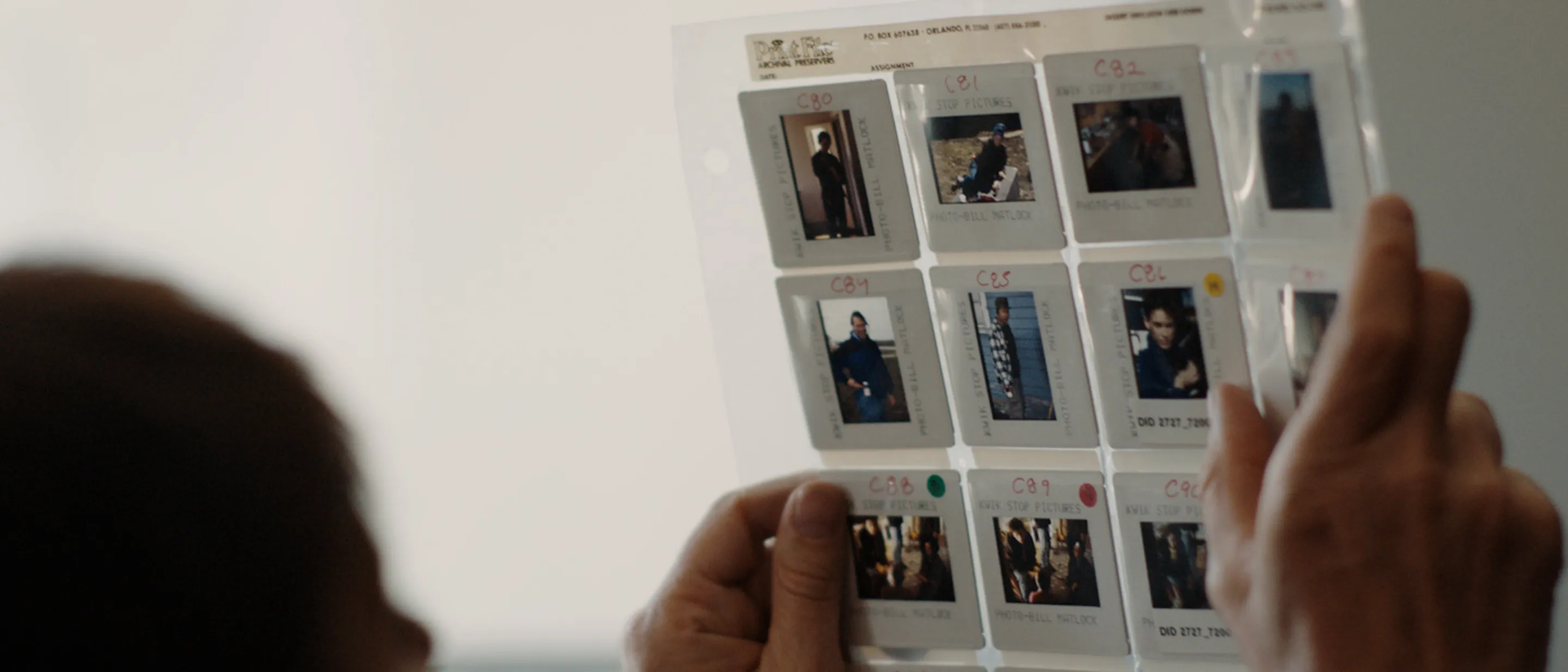
Related Material
Essays, interviews and other connections
![Alfonso Cuarón’s Melodrama]() Alfonso Cuarón’s MelodramaRead
Alfonso Cuarón’s MelodramaReadThe beating heart of the director’s Y tu mamá también and Roma is unabashed high emotion
By Tim Murphy
![Tapping the Source: Robert Towne]() Tapping the Source: Robert TowneRead
Tapping the Source: Robert TowneReadTalking Los Angeles water and power with the legendary screenwriter of Chinatown
By Chiara Barzini
![Chloë Sevigny’s Enduring Edge]() Chloë Sevigny’s Enduring EdgeRead
Chloë Sevigny’s Enduring EdgeReadThe actor reflects on her complex character in the landmark film Boys Don’t Cry
By Christopher Bollen
